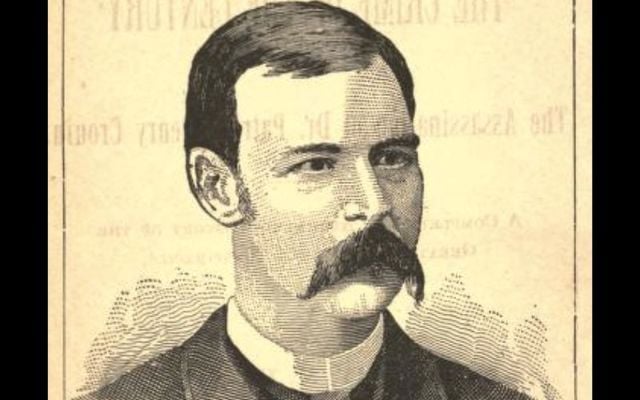Dr. Patrick Henry Cronin, a prominent Chicago doctor from County Cork, was murdered in 1889 after he accused the board of the Irish American political organization Clan-na-Gael of embezzling funds. The Chicago media called it "The Crime of the Century."
The story of the secret organization and the stabbing of the doctor is one of many tales of murder featured in the book ‘The Bloody Century: True Tales of Murder in 19th Century America.’
Clan-na-Gael was a secret organization created to promote Irish independence. It was formed to replace the Fenian Brotherhood after it was discredited in the U.S. following an ill-conceived attempt to invade Canada in 1866. Modeled after secret societies like the Freemasons, Clan-na-Gael, which was its public name, was known to its members as the United Brotherhood. It had an estimated 10,000 members.
Clan-na-Gael had chapters, known as camps, in every major city, reports MurderbyGaslight.com. The Chicago camp, Camp 20, was the organization’s headquarters.

Love Irish history? Share your favorite stories with other history buffs in the IrishCentral History Facebook group.
At a convention held in Chicago in 1881, Clan-na-Gael formed a five-man executive board to run the organization. Soon after, three of the board members — Alexander Sullivan of Chicago, Michael Boland of Louisville, and D.S. Freely of Rochester, NY — decided to work together and gain control of the organization. These three men became informally known as “The Triangle.”
When Clan-na-Gael was accused of supplying money and men for the “Dynamite War,” a terrorist campaign in England, The Triangle denied the charge. However, they were unable to account for between $100,000 and $250,000 of the organization’s funds.
When Dr. Cronin, a Clan-na-Gael member, publicly criticized the three men, The Triangle retaliated by accusing him of being a British spy.
Patrick Henry Cronin was born in County Cork in 1846 and moved with his family while he was still an infant to Canada.
He moved to St Louis at the age of 23. After working as a porter for a wholesale house, Cronin began studying pharmacy. He soon switched to medicine and graduated from the Missouri Medical College. He set up a practice in St Louis, where he joined Clan-na-Gael as well as a number of benevolent groups and secret societies such as Royal Arcanum and Chosen Friends. In 1882 he moved to Chicago, where he joined the Foresters and the Royal League.
It was in Chicago that he joined the anti-Triangle faction of Clan-na-Gael and became their spokesman.
After The Triangle accused him of being a spy, he was brought to trial before a committee of the organization’s members, including Dan Coughlin, a detective in the Chicago police department. Although Cronin was found guilty of treason and expelled from the order, he had attracted a large following within the organization with thousands of members quitting Clan-na-Gael in sympathy and forming their own camps.
Leaders of the different factions urged members to move on from the quarrel believing they all needed to work together to realize the goal of Irish independence. Cronin agreed provided The Triangle was fully investigated.
A committee of six members, including Cronin, was in charge of investigating The Triangle but voted four to two that the charges could not be proven. When Cronin threatened to make his notes of the proceedings public, Triangle leader Alexander Sullivan was purportedly heard to say he wanted Cronin “removed.”
On May 4, 1889, a man came to Cronin’s house in a carriage asking for assistance for an injured worker at O’Sulliavn’s ice house. Dr. Cronin had been approached by Patrick O’Sullivan, owner of an ice house at Lake View, offering him a job as the company physician, and Cronin would respond whenever one of O’Sullivan’s employees needed medical attention.
Eyewitnesses saw Dr. Cronin leave on May 4 in a carriage pulled by a white horse. He never returned.
Soon after, a blood-stained trunk was found north of the city containing what appeared to be strands of the doctor’s hair, and Cronin’s friends were convinced he had been murdered. But then he was reportedly seen on a streetcar by a friend late that night, and the sighting was verified by the streetcar conductor.
On May 10, the newspapers in Chicago received a dispatch from Toronto claiming that Cronin was in Canada. It said he had admitted to being a British spy and was on his way to England.
Then, on May 22, the public works department in Lake View went to investigate a jammed sewer and found Cronin’s decomposing naked body wedged into the catch basin. He had a bloody towel wrapped around his neck; beneath the towel, he wore an Agnus Dei— a Catholic medal depicting the Lamb of God.
The coroner found Cronin had five scalp wounds made by a sharp, narrow weapon, possibly an ice pick.
Neighbors near O’Sullivan’s ice house told investigators that a strange man had rented a cottage nearby and never moved in, although lights sometimes burned inside late at night.
When police went into the cottage, they discovered a considerable amount of blood on the front steps and in several of the rooms, and the floor had recently been painted yellow in an attempt to hide the blood.
The furniture in the cottage was traced to Revel’s furniture store. The furniture, as well as the trunk, had been rented by a man named J.B. Simmonds. Detectives suspected that Simmonds was actually Pat Cooney, alias “The Fox,” a companion of O’Sullivan and Detective Coughlin, and an enemy of Dr Cronin.
Police found the horse and carriage had been rented on the day of the murder by Detective Dan Coughlin. John Kunze, a friend of Coughlin's, was identified as the man who drove the carriage.

Looking for Irish book recommendations or to meet with others who share your love for Irish literature? Join IrishCentral’s Book Club on Facebook and enjoy our book-loving community.
On June 29, O’Sullivan, Coughlin, Cooney, and Kunze were indicted for the murder of Dr. Cronin, along with Frank Burke, Frank Woodruff, and John Beggs, members of Camp 20 and associates of Coughlin.
At the recommendation of the coroner’s jury, Alexander Sullivan was also arrested. Sullivan had been arrested for murder in 1876 after he got into a squabble and shot and killed Frank Hanford, the principal of the school where Sullivan’s wife was teaching. Hanford had accused Mrs. Sullivan of creating dissension on the school board. Alexander Sullivan was acquitted of Hanford’s murder after two trials. For the Cronin murder, he was released on $20,000 bail and charges were eventually dropped due to lack of evidence.
The Cronin murder trial lasted three and a half months with closing arguments lasting fourteen days.
The jury deliberated for 70 hours before issuing the verdicts. John F. Beggs was not guilty; John Kunze was found guilty of manslaughter, and Dan Coughlin, Patrick O’Sullivan, and Martin Burke were all found guilty of first-degree murder.
However, Kunze appealed and was granted a new trial which resulted in his acquittal, while Coughlin was granted a new trial on the grounds that two jurors were prejudiced against him and was acquitted on his second trial. Frank Woodruff’s case was stricken from the docket due to lack of evidence.
Dan Coughlin opened a saloon in Chicago after his release from prison but soon fled to Honduras after he was charged with attempting to bribe jurors in lawsuits connected with his time as an employee of the Illinois Railway Company. Martin Burke and Patrick O’Sullivan died in the penitentiary.
Nearly 8,000 men, including Hibernians, Clan-na-Gaels, Foresters, and others, marched in Dr Cronin’s funeral. The procession included several drum corps and a marching band and was one of Chicago’s most spectacular funerals.
* ‘The Bloody Century: True Tales of Murder in 19th Century America’ is available on Amazon.
*Originally published in June 2016. Updated in May 2023.




Comments